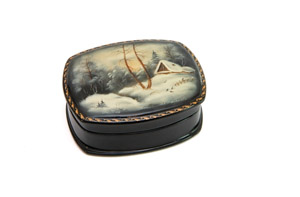Russian Lacquer Boxes
 Traditionally lacquer boxes are made of papier-mache. Papier-mache is used because, when prepared properly, it is stronger than wood and does not warp.
Traditionally lacquer boxes are made of papier-mache. Papier-mache is used because, when prepared properly, it is stronger than wood and does not warp.
To make a papier-mache box first many sheets of a kind of cardboard are pasted together with a glue mixture, wound around a mold, pressed, and are then left to dry. Once dry, the papier-mache is boiled in linseed oil. It is then placed in an oven where it is heated very slowly to 212 degrees Fahrenheit and is then brought back to room temperature. This heating and cooling takes many days.
The pieces of papier-mache are then cut into the sizes necessary for the boxes. The pieces of the box are then joined together. Coats of a black paste are then applied. After each coat the box is placed in an oven for a day. Next the box is smoothed. Coats of the base lacquer (usually black or red) are then applied to the box. The box is then covered with a few coats of clear lacquer.
The artist then paints the box, using brushes as fine as a single squirrel's hair for the details. Once the box is painted, the artist applies the gold work. A sheet of gold leaf is ground and combined with an egg solution. The gold leaf is then painted on. To make the gold glisten it must be very thoroughly shined. This is done with a very smooth surface: a wolf's tooth.
To finish the box more coats of clear lacquer are applied.
Higher quality boxes are always painted on papier-mache. Some less-expensive boxes, however, are painted on wood or plastic (no boxes offered for sale at this website are plastic). On this website boxes that are not made of papier-mache are clearly identified as such.
Also, some people have manufactured boxes that are not hand-painted; instead, printed images are placed under the lacquer.
There are four kinds of Russian lacquer boxes named after the villages where they are created: Fedoskino, Palekh, Kholui and Mstera.
Fedoskino
Fedoskino is a Russian village close to Moscow which has been a center of Russian lacquer box painting since the late 18th century. Fedoskino artists paint scenes of village life, portraits, scenes from fairy tales, and landscapes on papier-mache boxes.
Fedoskino artists paint with oil paints. Unlike the artists of the three other schools, Fedoskino artists often place pieces of mother of pearl under the lacquer to give their paintings an added depth and glimmer.
Palekh
Palekh is a Russian village not far from Moscow that has been a center of Russian icon painting since the 18th century. With the 1917 Revolution and the subsequent government fight against religion, the demand for Palekh's beautiful icons dried up.
Palekh's icon painters looked to another great painting village, Fedoskino, for guidance. Since the late 18th century artists in Fedoskino had been creating miniature paintings on papier-mache boxes. Fedoskino artists painted portraits, scenes from fairy tales, landscapes, and scenes of village life. Palekh artists replicated the Fedoskino themes, but maintained traditional Palekh painting styles.
Palekh artists paint with egg tempera paints. Gold leaf is often used to accentuate the paintings.
Kholui
The old village of Kholui, one of the most ancient villages in the Vladimir - Suzdal area in Russia, is a large canter of icon and miniature painting. In Kholui the first paintings on Papier-mache go back to the beginning of the 20th century a simple motif, was used by the artist to create a poetic image of peasant life. The Kholui styles are more open to change. And nowadays, the Artists reshape the imagery structure of their miniatures so that we can admire the scenes from fairytales and ballads, beautiful Russian landscapes, and old villages with their unforgettable churches and cathedrals.
Artists in the village of Kholui have been painting icons since the eighteenth century. According to the Russian Orthodox Church, the Kholui icons were not to the same quality as the Palekh and Mstera icons. The painting style was more realistic than the church wanted.
With the 1917 Revolution and the subsequent government fight against religion, the demand for Kholui's icons dried up. In the 1930s painters in Kholui began painting lacquer boxes.
Kholui boxes usually depict scenes from fairy tales and village life. The boxes are painted with egg tempera paints.
Mstera
Artists in the village of Mstera have been painting icons since the seventeenth century. With the 1917 Revolution and the subsequent government fight against religion, the demand for Mstera's icons dried up. Mstera artists applied their icon painting styles to lacquer boxes. They mainly painted scenes from fairy tales, floral scenes, and scenes of village life.
Mstera miniature paintings are often heavily influenced by the idyllic scenery that surrounds the village; landscape and backgrounds are usually more central to Mstera boxes than to boxes from the other three schools.
Mstera artists paint with egg tempera paints.